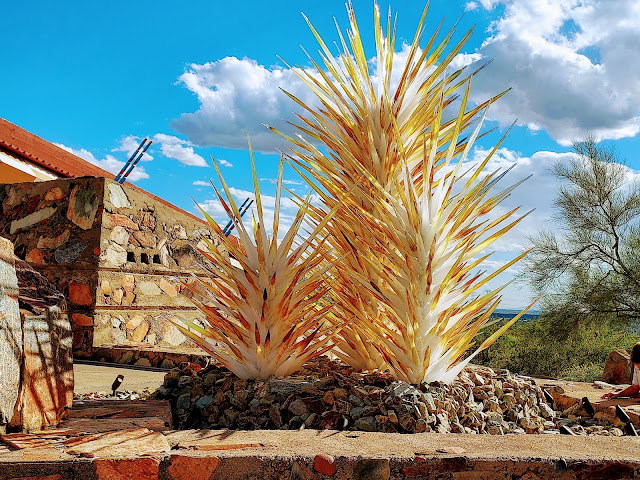One thing Dear Husband brought to our relationship is an appreciation of Frank Lloyd Wright architecture and design. We have been to most of his major sites (just search my blog for his name to see my other reviews), so when I saw an advertisement on social media for a Dale Chihuly exhibit at his winter estate, Taliesin West, I very badly wanted to see it in person. (I brought a love of art glass.) I planned a spring break trip to allow us to spend >50% of our time out of doors. It was cooler than we had hoped, so we started our trip with a visit to the Musical Instrument Museum, and then drove over to Cactus Drive for the height of the afternoon warmth.
Our tour guide, Jacob, must do stand-up comedy on the side, because he had lots of jokes--both one-liners and long set ups--as we circumnavigated the public parts of the site. Here you can see him starting the tour in front of the rock with the ancient petroglyph of a squared-off spiral that is the symbol for Taliesin West. You can see the shape again in the entrance artwork in the first photo, for instance.
When in 1937 Wright's doctors told him he needed a warmer, drier climate for his health, he was only too glad to leave snowy Wisconsin winters behind for the sunny desert of Arizona. Eventually his architectural fellows packed up, moved south, and built the campus according to his ideas with their own hands. The 600+ acres northeast of Phoenix are one of eight FLW locations designated UNESCO World Heritage Sites. Most of the structures are made of scavenged desert rock dry cemented together, so they are very much connected to the place. But they also look...amateur, unlike the professional masonry elsewhere.
To the left you see one of thirteen ceramic vignettes Wright bought for cheap from a San Francisco dealer, since they had been damaged in transit. They look old and weathered despite his apprentices' best efforts to reconstruct them. Their character tells you something about Wright's character.
There are lots of great geometrical shapes in the buildings, and plenty of Wright's signature reds. Here is the domed water fountain that burbles at the center of the compound.
Besides it are three enormous orange, white, and yellow yucca plants out of glass.
In front of the drafting studio are Chihuly's famous red reeds, interspersed with glass orbs that are larger and more colorful than the Japanese fishing net floats on which they are modeled.
I didn't appreciate this until Jacob pointed it out, but pool has actually been dyed black to make it more reflective. The reeds stand taller, and the colors of the orbs pop.
Honestly, I couldn't imagine Taliesin without the Chihuly pieces;
this is always what it will look like in my mind's eye.
Reportedly the glass saguaro and yucca are even more beautiful in the setting sun, but I wasn't sure about signing up for cocktail hour, what with COVID. We were I think the only people masked on our tour.
Here at "the prow" of the site, the point faces west so Wright could watch the sun set and the shadows race across the desert like waves of darkness. Jacob pointed out the really cool detail of how the "desert" shapes of the glass could also be "sea" shapes, like kelp, jellyfish, and anemone.
Inside the space Wright used as a den and living room, now decorated with his likeness.
A Chihuly "basket" modeled after Native American baskets, with the "moon door" in the background.
No Hobbit sightings have been reported recently.
This is a fire-breathing dragon (no really, it does spit fire for special occasions)
given to Wright's third wife, Olgivanna, to protect the estate.
As much as I loved the black pool out front, these red reeds may have been my favorite installation piece. They stand between the water tower and the windowless kiva, which Wright used as a storage room when they had de-camped to Wisconsin for the summer, and as one of three movie theaters on the property. Apparently he was quite the cinephile.
To the left, the dinner bell overhanging the residential quarters, which we could not see because they are still in use, and another of those ceramic Chinese vignettes. To the right, a massive Chihuly "chandelier" stands guards over the orange orchard.
With this panoramic view you can see the straight, horizontal "Prairie" lines that characterize
Wright's older work, as well as the "Cherokee" red mirrored in Chihuly's glass,
the green left over from the desert winter or signaling the coming spring,
and blues in the glass saguaro "cacti" and of course that big, big sky.






















No comments:
Post a Comment
Your comments let me know that I am not just releasing these thoughts into the Ether...